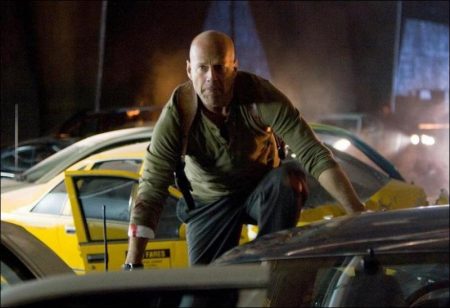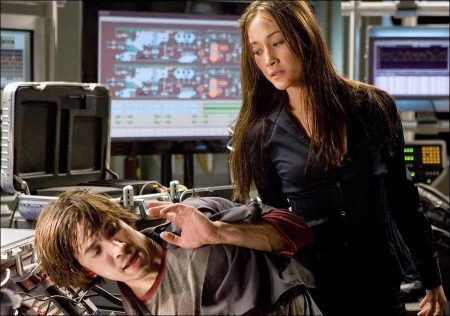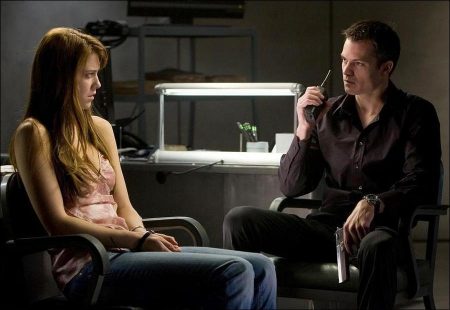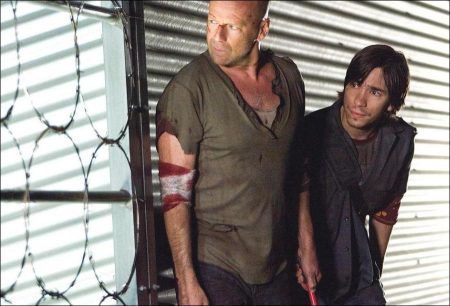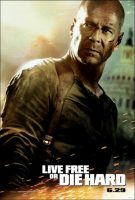Taglines: Yippee Ki Yay Mo – John 6:27
On the Fourth of July weekend, an attack on the vulnerable United States infrastructure begins to shut down the entire nation. The mysterious figure behind the scheme has figured out every modern angle…but he never figured on McClane – the oldschool “analog” fly in the “digital” ointment.
It’s the beginning of the holiday, but New York City Detective McClane isn’t celebrating. He’s had yet another argument with his college-age daughter Lucy, and received a crushingly routine assignment to bring in a young hacker, Matt Farrell, for questioning by the FBI. But for McClane, the ordinary has a habit of exploding into the extraordinary – abruptly hurtling him into the wrong place at the wrong time.
With Farrell’s help, McClane slowly begins to understand the increasing chaos surrounding him. An attack is underway on the vulnerable United States infrastructure, shutting down the entire nation. The mysterious figure behind the scheme, Thomas Gabriel, stays several moves ahead of McClane as he implements his incredible plans, known to uber-geeks like Farrell as a “fire sale” (as in, everything must go!).
Live Free or Die Hard eschews computer generated fantasy for practical action set pieces. John McClane’s sardonic sense of humor always feels genuine and relatable. And, most importantly, the film is character-driven, anchored by one of pop culture’s toughest yet most endearing everyman heroes.
Keeping it real was never far from Bruce Willis’ mind as he contemplated returning to the character that helped redefine cinema action heroes. “One of the most exciting things about playing McClane is that he’s definitely not a superhero,” says Willis. “He has no special powers or abilities. He’s a regular guy to whom anybody can relate. While we’re always pushing the envelope to create great action sequences, I think it is McClane’s relatability and sense of humor that really draws in people.
“Over the years, there’d been talk about a new Die Hard picture but nothing really gelled for me until we came up with the angle of the two things most important to McClane being threatened,” Willis continues. “McClane loves his family and his country, above all, and he despises anyone who preys on people who cannot defend themselves. This was a fresh take on the character, but it always stayed true to his nature. The stakes are higher now for McClane but he’s still the regular guy unexpectedly confronted with some very irregular circumstances.”
Willis notes that the stakes were higher for him. “I’m a gambling man by nature, and I wanted to see if we could meet the challenge of creating a great story,” he points out. “I really wanted to live up to the first Die Hard. I gave a lot of thought to that.”
Mark Bomback’s screenplay, based on a story by Bomback and David Marconi, had drawn Willis’ interest, but he didn’t fully commit to the project until director Len Wiseman joined the project. Willis had watched Wiseman’s thriller, Underworld: Evolution, which impressed Willis with its singular vision. “I was completely sucked into Len’s film,” Willis remembers. “You could tell somebody was definitely steering the ship because the world of the film never deviated. I thought Len could bring a lot to a new Die Hard film – and he did.”
Wiseman taking the reins of Live Free or Die Hard seemed like a prophecy fulfilled: As a high school student, he made a Die Hard-inspired “movie” with some friends. “I love Die Hard,” Wiseman recalls. “I was especially drawn to McClane’s vulnerability. He’s a guy who has been thrust into an unexpected situation, and he’s none too happy about it. Anyone can relate to that.”
Wiseman’s take on the character and story was critical in shaping Live Free or Die Hard. Simply put, he wanted to be true to McClane. Wiseman recalls one instance in an early script draft of an unlikely McClane moment that needed a course correction.
“There was a scene where McClane walks into a police station and asks, ‘What can I do to help?’ And I said, ‘McClane doesn’t offer to help – ever.’ Bruce sparked to that.”
Wiseman, while intent on Live Free or Die Hard staying true to John McClane, worked with Willis and Bomback to create additional nuances for the character. “I wanted to explore another level of McClane as he faces new challenges,” says the director. “How would he react if his daughter is threatened? What kind of effect does being a hero – even a reluctant one – have on your family and relationships?
“In this film, McClane is out of his element more than ever,” Wiseman continues. “This is the ultimate McClane-esque scenario because he’s an old-school cop who finds himself up against a new kind of tech-savvy villain.”
Willis also wanted to make sure the script didn’t ignore the passage of time. “We don’t pretend that McClane is the same guy he was in the original Die Hard,” he says. “Obviously, he’s older – his daughter Lucy, whom we met as a child in the first film, is now a college student. He’s more weary and cynical. But it’s important to note that McClane has never seen himself as an action hero.”
With input from Willis and Wiseman, Bomback’s screenplay became grittier, the action more in-your-face, and the time frame more compressed. “It really became visceral, stunt-driven and real,” says Bomback. “Anything that could go wrong for McClane did go wrong. We were always thinking of new ways to complicate McClane’s life by putting him in seemingly impossible situations. Of course, then we had to figure out how to get him out of it.”
Willis and Wiseman worked tirelessly to make the film a huge thrill ride while staying true to the character. “This film was the most draining of the Die Hard films, both physically and mentally,” says Willis. “I will have been working on this film for an entire year by the time it opens. But it’s most rewarding from an artistic standpoint.”
“Having played the character previously and being so closely identified with McClane, Bruce brought a critical level of experience to the project,” says Mark Bomback. “In a way, McClane is another version of Bruce. There’s no one else who could play that part. During our script meetings Bruce would say something like, ‘I don’t think McClane would say that; he might say this.’ And then we’d suddenly realize that Bruce’s idea was more appropriate to the character and to a Die Hard film.”
The Die Hard films are renowned for their non-stop action, and Live Free or Die Hard offers some of the biggest, most realistic set pieces seen in films today. “I thought about the kind of situations we could put McClane in, that I would want to see as a fan,” Wiseman explains. “And we came up with some wild stuff – McClane-esque action that was real, gritty and bare-bones.”
“We always envisioned Live Free or Die Hard as a straight-ahead action ride, that was true to the tone and character of the original but updated for today,” adds Willis. “I can tell you we’ve more than met that goal. This isn’t one of those films that is completely reliant on CG effects…I’ve done those films and there’s nothing wrong with them, but in the spirit of Die Hard, the action had to be smashmouth, and I think we’ve more than accomplished our goal. You get real action and stunts. It’s gritty and big, everything you’d expect and want in a Die Hard movie.”
A few of the film’s action highlights:
— a sedan hurtles through the air toward McClane and Farrell, seconds from crushing them, before the sedan lands on the passing cars and bounces over the two men;
— McClane’s patrol car sails skyward like a fiery missile into a helicopter;
— McClane and Gabriel’s girlfriend and chief operative, Mai (Maggie Q) engage in a vicious, close-quarters fight, trading punches and kicks inside a car dangling vertically in an elevator shaft;
— another Gabriel operative, Rand (played by famed French action star Cyril Raffaelli) jumps across a building, lands on an air conditioning unit, jumps over to a fire escape, rappels down another fire escape, and swings down onto a third fire escape – all in one take, which has never before been done on film; and — in an explosive freeway chase sequence, a Harrier jet pursues, fires upon, and virtually destroys a big rig driven by McClane.
During production, Wiseman worked closely with stunt coordinator Brad Martin and special effects supervisor Mike Meinardus to create the action. “Len’s mandate was that if a stunt could be done practically, without computer generated imagery, that’s how he wanted it done,” says Martin. (Visual Effects Supervisor Patrick McClung supplemented the mostly-practical scenes with what he calls “invisible” CGI.)
Much of the action was designed around McClane’s old-school, dirt-under-his fingernails ways, as he uses anything available – his fists, guns, fire extinguishers, even helicopters – to battle Gabriel and his operatives. And Willis was more than up for the physical rigors of the shoot. “This is a Die Hard film, which means that McClane is put through the wringer,” Willis points out. “I wanted McClane to look like he could still take whatever’s thrown at him, so I underwent a rigorous training regimen for several months prior to the start of production. McClane’s older and so am I – and that was part of the fun of returning to the character. But I also realized there is a benefit to getting older. You pay attention, and you acquire some wisdom.
“Bruce would say, ‘You know, we really have to beat the crap out of me in this scene,’” adds Wiseman. “And he is in great physical shape. Equally important, Bruce has a certain look in his eyes that tells you he can withstand a lot.”
Always mindful of keeping the action real no matter how elaborate and explosive, Wiseman, Martin and Willis explore the physical consequences on McClane. “We’d ask ourselves questions like, ‘What would happen if McClane fell off a one-story building and then clipped something on his way down?’” Martin recalls. “Our stunts had to have a purpose, because McClane does nothing without a reason and usually only because he lacks another choice.”
Many of the film’s explosive reality-based action scenes take place on enormous, stylized sets created by production designer Patrick Tatopoulos (Independence Day). Tatopoulos’ practical sets not only looked huge, they created the foundation necessary for the filmmakers to get extreme with the action sequences. “Production design is more than creating a space,” explains Tatopoulos. “It’s thinking about how to make the action work in that space. It’s more like delivering a tool – a playground for people to work with. I’m a big fan of practical sets. I like to build things.”
Humor plays an equally important role in Live Free or Die Hard. McClane’s sardonic wisecracks have provided many of the highlights of the Die Hard films, and Live Free or Die Hard more than lives up to that tradition. “I’m very protective of McClane and aware that there’s a fine line between poking fun at the character and laughing at him,” says Willis. “We always want audiences to relate to him, and one way to do that is through laughter.”
Moreover, the film’s humor further blurs the line between Willis and his onscreen alter ego. “Bruce is a regular guy from New Jersey who tells and laughs at silly jokes, and likes nothing more than being with his family,” says Mark Bomback. “Those qualities are what make Bruce – and McClane – so likable.”
Bomback says that coming up with the numerous “McClane-isms” was the most enjoyable part of writing the script. “I love the character of John McClane. Whenever I would feel intimidated by a scene or wonder how I was going to pull it off, the McClane ‘voice’ allowed me to write it. It was such a pleasure to think of what McClane would say in a given situation.”
Much of the humor stems from the counterpoint of McClane’s old-school ways and Gabriel’s modern methods. “The digital world has kind of left him by,” says Willis.
“We didn’t want to suddenly make McClane computer-savvy and be able to stop Gabriel and hack into satellites. McClane wouldn’t know how to do that. So we have some fun putting him in situations he doesn’t understand, and pitting him against a bad guy using tools and methods McClane’s completely unfamiliar with.”
But Gabriel underestimates McClane, the ultimate “die-hard” who begins to turn the tables on his adversary – all the while unleashing a torrent of wisecracks, including McClane’s signature quip, “Yipee-Ki-Yay.” “That expression has become part of the Die Hard mythology over time,” says Willis. “At the time I first said it, in Die Hard, it was just a cool thing to say to Alan Rickman [as the villainous Hans Gruber], when he was calling me ‘Mr. Cowboy.’ I am amazed that such a simple line would become part of the language of pop culture. But McClane says it now under many circumstances, mainly when he is trying to be extra indecipherable.”
Tech-savvy Matt Farrell, another subject of McClane’s barbs, is the digital yin to McClane’s analog yang. “Matt’s a fun foil for McClane,” notes Justin Long, the young star of such films as Dodgeball: A True Underdog Story and Galaxy Quest, and who can be seen in a series of popular Apple Computer commercials. “He’s very different from McClane’s ‘partners’ in the previous Die Hard films; he’s not a cop or a streetwise guy. Matt’s a man of technology, while McClane’s a man of action. A lot of fun comes from their interaction.
“Matt’s definitely not physical,” adds Long. “How could he be? He’s obsessed with his computer and never leaves home.”
A character with a more athletic bent is Mai, the chief operative of – and girlfriend to – Thomas Gabriel. Maggie Q, who had a starring role in Mission: Impossible III, is a skilled martial artist, and her no-holds-barred on-screen bouts with Willis had a powerful “East versus West” flair. “Mai is more physical than anything else,” says Maggie. “She’s quick, savvy and lethal. McClane has his old-school fighting techniques, and Mai has her new combat methods. It makes for an interesting dynamic.”
Mai’s boss (and paramour), Gabriel, works more with his brain than with brawn. The architect of a plan to bring down the nation’s digital infrastructure, Gabriel is an adversary the likes of which McClane has not previously encountered. “Gabriel is capable of certain methods that McClane is unable to foresee because they’re out of his realm of experience,” explains Timothy Olyphant.
If villains in the Die Hard films are defined by their cleverness and how many moves they’re ahead of McClane and the audience, then Gabriel ranks among the series’ most intriguing. Certainly, Gabriel’s plans raise the stakes much higher than in previous Die Hard films. He is not trying to rob a corporation, or a city’s financial district; he’s bringing down an entire country. And Gabriel is doing it, he believes, for a good reason.
“Gabriel has an agenda with the government, and he’s now in a position to give the American public a strong reality check,” adds Olyphant.
Like most memorable cinema villains, Gabriel is charismatic, charming, brilliant and intense – a combination of qualities that made the character challenging to cast. “Gabriel is brilliant and sophisticated, but at the same time he often seems like he’s on the verge of snapping because he takes things way too far. And Tim has that quality about him,” Wiseman laughs.
When McClane threatens to upset Gabriel’s plans, Gabriel kidnaps McClane’s daughter Lucy to keep him at bay. That, as Gabriel learns, is a big mistake. “We haven’t seen Lucy since Die Hard, and then only briefly as a child,” says Willis. “Now, she’s a college student and not on the best of terms with McClane. But even though McClane is divorced and on his own, he’s still very much a family man. And he’ll stop at nothing to save his daughter.”
“The kidnapping of Lucy ups the emotional stakes for McClane,” Willis adds. “It provides an important emotional drive, along with the huge events unfolding around him.”
Lucy, as played by Mary Elizabeth Winstead, is definitely her father’s daughter. “She’s feisty with a lot of the McClane spirit and toughness,” says Winstead. “When the story begins, Lucy’s relationship with her father is strained because he was absent from most of her young life. Of course, everything changes when Lucy is threatened by Gabriel.”
To stop Gabriel, McClane must rely on the digital savvy of reluctant cohort Matt Farrell, as well as master hacker known as Warlock. Ensconced in his “nerve center” (actually his mom’s basement), Warlock provides McClane and Farrell with critical information and a lot of attitude. Actor-filmmaker-website proprietor Kevin Smith admits to being typecast as Freddy. “I spend a lot of time online. There are days I wake up, spend all day online, then go to bed.”
Smith, like Len Wiseman, found his involvement in a new Die Hard picture to have a special resonance. “I didn’t shoot a Die Hard movie in high school, like Len did,” says Smith, “but I did host a viewing party of the film when it came out on VHS. I was fascinated by how real McClane was – that he was one of the first action heroes to actually appear damaged by the adventure he’d just undertaken.”
Indeed, the films’ legacy, its believable everyman hero and its huge yet largely practical action set pieces, defined much of the filmmakers’ excitement about making Live Free or Die Hard. “On a given day, there’d be a Harrier Jet under construction, freeway sections we were building, a forty-foot trailer suspended in the sky– and four cranes poised to capture the day’s action,” remembers Len Wiseman. “I’d walk out on the set, look around, and think, ‘This is a pretty cool job.’ And a far cry from my backyard in Fremont!”
“It was combat every day while preparing and making this movie, but I’m ecstatic with the job everybody has done,” concludes Bruce Willis. “A lot of people love these films and think the first one reinvented the action genre. So we had a lot to live up to with Live Free or Die Hard. “I’ve already gone on record as saying it is as good if not better than the Die Hard. It gives audiences everything they love about Die Hard and McClane, while upping the stakes and reinventing the playing field.”
Live Free or Die Hard (2007)
Directed by: Len Wiseman
Starring: Bruce Willis, Timothy Olyphant, Maggie Q, Justin Long, Jeffrey Wright, Mary Elizabeth Winstead, Cyril Raffaelli, Jonathan Sadowski, Christina Chang, Chris Palermo
Screenplay by: Mark Bomback
Production Design by: Patrick Tatopoulos
Cinematography by: Simon Duggan
Film Editing by: Andrew Mondshein
Costume Design by: Denise Wingate
Set Decoration by: Robert Gould
Art Direction by: Beat Frutiger, James Hegedus, Troy Sizemore
Music by: Marco Beltrami
MPAA Rating: PG-13 for intense sequences of violence and action, language, and a brief sexual situation.
Distributed by: 20th Century Fox
Release Date: June 27, 2007
Visits: 55
